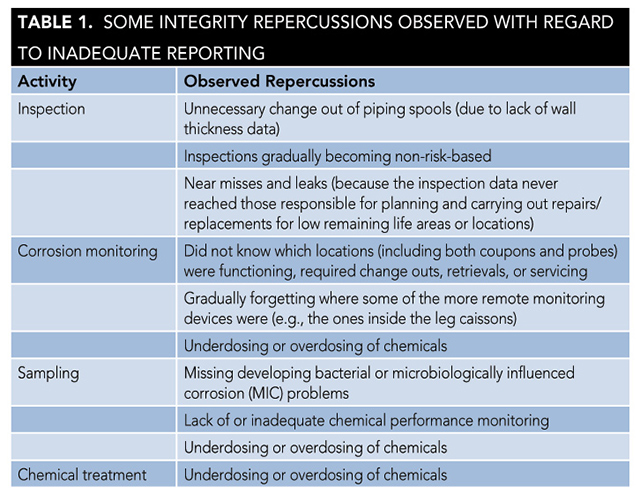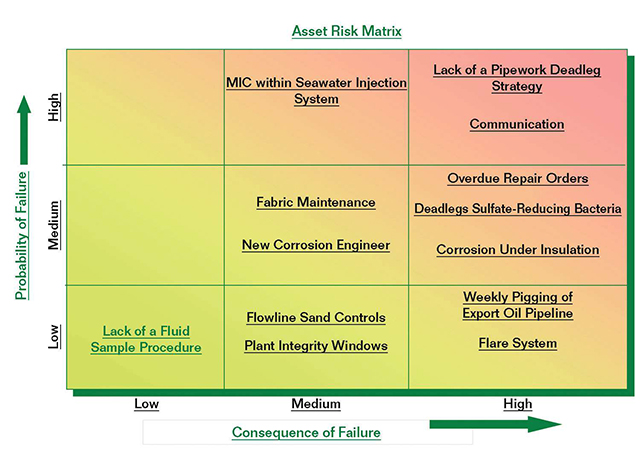A sound corrosion-related decision plan, assessment, or strategy is often based on initial inspection, sampling, or chemical treatment data. Integrity and corrosion engineers, inspection engineers, chemical engineers, process engineers, operations managers, integrity managers, and owners could make more relevant and efficient technical decisions and plans if they continuously and regularly receive pertinent asset data, information, and performance indicators.
For many assets, particularly more mature assets where corrosion is often a bigger issue, there is a crucial requirement for a regular flow of information so the best and most cost-effective technical, integrity, and financial decisions can be made. This necessitates a regular, organized, effective, and transparent reporting system to facilitate existing or upcoming assessments, planning, and mitigation activities. Monthly or regular corrosion reporting can be used to fulfill all such requirements. Based on past field experience, regular reporting can have a significant positive impact on an incumbent asset integrity management system (AIMS) and simultaneously optimize the associated costs.
Repercussions of Inadequate Corrosion Reporting
Depending on the significance of the corrosion threat associated with an asset, various regular activities may be done to further quantify the corrosion rate or mitigate the corrosion. These include:
- Inspection (including intelligent pigging of pipelines)
- Corrosion rate monitoring
- Fluid sampling
- Chemical treatment
- Cleaning
- Repairs and replacements
Simultaneously, the findings of these activities must be accurately recorded, reported, and disseminated among the relevant individuals and disciplines. The distribution of results will constantly improve knowledge and understanding about the following conditions:
-
Integrity condition of the asset
- Specific problem areas
- Performance of various mitigation activities
- Specific integrity shortcomings
- Future corrosion mitigation needs
- Future repair/replacement requirements
- Required resources and budgets
The better the asset is known from an integrity or corrosion point of view, the more effective and efficient upcoming technical assessments, plans, treatments, and activities will be.
In the absence of regular reporting, those in charge may not be adequately informed or best placed to make and implement the most appropriate and cost-effective corrosion-control decisions. In some cases, the reporting is so poor that it appears as though some of the ongoing activities (e.g., inspection, monitoring, and fluid sampling) are not actually taking place. This issue is sometimes exacerbated when one individual is the sole recipient or custodian of the data and moves on, leaving no one with access to the data or knowledge of where they were kept.

Table 1 shows examples of how inadequate recording, reporting, and dissemination of pertinent information adversely affects the AIMS and pushes costs unnecessarily high. A typical activity and the resulting repercussions of poor or inadequate reporting are listed in the following column. The outcome of all these cases is progressively exacerbated asset integrity conditions and a simultaneous increase in integrity costs.
Proposed Structure and Content
Structure and Content
Ideally, a corrosion report document should incorporate the following main components:
-
Administrative: Report author, distribution list, meeting attendees, and absentees (to be completed during the meeting); date and venue of the current and upcoming meetings; etc.
- Integrity-related information and data: Various ongoing or planned activities conducted (e.g., inspection, corrosion monitoring, cleaning, intelligent pigging, and repairs/replacements) and their findings and outcomes, as well as any associated shortcomings (e.g., noncompliances with specifications or plans and unreliability or inaccuracy of the data). Reasons or explanations should be provided as to why certain activities had not met their targets or compliances, and proposed solutions or rectifying and improvement actions, etc., should be included.
- Corrosion key performance indicators (KPIs): A numerical (or graphical) summary of the performance of various critical activities, or the magnitude of certain variables/parameters with regard to acceptable limits, ranges, or specifications.1
- Asset risk matrix: A risk matrix that highlights the threat posed by various factors to the overall integrity of the asset or its integrity management (Figure 1). Of paramount importance is the fact that all such threats are not necessarily corrosion related and could be any factor or variable associated with shortcomings, ineffectiveness, or drawbacks that could adversely affect the AIMS.2 It is therefore the responsibility of the corrosion team to discuss such parameters during each meeting to determine the risk posed to asset integrity. These parameters include:
- A particular damage mechanism
- Management-related issues (e.g., reduced integrity budget for the following year)
- Inadequate communication
- Particular system or equipment problems
- Lack of or inadequate processes/ procedures (e.g., lack of fluid sampling or probe servicing procedures)
Once items have been placed on the risk matrix, then activities have to be suggested or planned based on the risk these items pose to the asset’s integrity, so the associated risk is reduced to an acceptable level.
- Meeting minutes: The minutes should include the topics discussed, training needs, future actions and activities, the assigned actions, and the associated deadlines. These may be kept in a separate document, but it is assumed that the minutes are also part of the overall corrosion report.

Proposed Presentation Format, Reporting Frequency, and Distribution List
Presentation Format
When explanations, descriptions, or justifications are required, clear and concise language has to be used. When results are to be presented, a mixture of text, figures, and graphs should be used. If data are being presented or discussed, highlight any potential issues with regard to data reliability and accuracy. Try to make good use of data by presenting them all and interlinking or comparing them with other sets of data. Highlight data to show if they are in agreement with other data (e.g., corrosion monitoring and inspection data both point to similar corrosion rates) or if they do not support each other and there are discrepancies. This possibly could be a sign that either the activities were not carried out properly or there are issues associated with data reliability and accuracy. Thereafter, offer solutions to rectify data conflicts. Try to use all the data to produce a more transparent and thorough picture of the integrity condition of the asset and any associated shortcomings. Avoid ambiguous statements and disclose negative news, poor compliance, or weak performance. For most issues, the sooner they are raised and addressed, the easier and cheaper it may be to rectify them. Similarly, avoid leaving new or pending issues for future meetings or for other individuals and colleagues. With corrosion management, be open, honest, prompt, clear, and responsible.
Reporting Frequency
If corrosion is a major integrity threat, or a wide variety of integrity-related activities are ongoing at all times, then corrosion reporting should be performed monthly. Otherwise, bimonthly or quarterly corrosion reporting should be adequate.
Distribution List
The distribution list should include the following individuals, disciplines, and groups:
-
The asset inspection, process, and operation departments
- The repair/maintenance representative
- The corrosion or integrity managers from both the client and the contractor(s)
- The asset chemist or the representatives of the chemical(s) suppliers
- The asset or installation manager
- Any other person or group who is involved or interested in the asset’s integrity management
General Recommendations in Regard to Regular Corrosion Reporting
Based on past experience, the following recommendations will enhance the content, presentation, and quality of regular corrosion reporting:
-
Have the report written by a single author rather than multiple authors. The author has to receive and review all the pertinent information (e.g., inspection, corrosion monitoring, sampling, and chemical treatment) and then compile and incorporate it into one single report document.
-
Organize and save the various input sent to the author as clearly as possible in relevant databases. This will facilitate future audits on the integrity management system—in particular, how such data are received, recorded, analyzed, trended, processed, and verified. Any adjustments and/or corrections applied to the input data should be mentioned in the report or communicated to the meeting attendees.
- Have an experienced corrosion engineer, or someone who is fully conversant with corrosion engineering basics, concepts, and data, write the corrosion report. Someone unfamiliar with corrosion may not be able to properly review, verify, analyze, trend, and present the pertinent data, or may miss vital clues associated with emerging corrosion issues.
-
Issue the corrosion report at least five days before the actual meeting date so all the attendees have enough time to review the report content and note their questions, comments, and suggestions. 5.Color code data (e.g., a traffic light system using green, yellow, and red) in high-level corrosion reports issued to management. The initial corrosion report, however, should not be color coded for the following reasons:
-
Color code data (e.g., a traffic light system using green, yellow, and red) in high-level corrosion reports issued to management. The initial corrosion report, however, should not be color coded for the following reasons:
-
Such a report reduces transparency. It also, to some extent, masks ongoing or developing issues, since a color may not highlight the exact magnitude or severity of a problem as efficiently as a number or figure.
-
In some cases, the ranges associated with colors (e.g., green, yellow, orange, and red, as used in Figure 1) can be rather wide or much extended. For example, a particular compliance or performance may be designated as green as long as it is >85%, or it may be designated as yellow (or orange) if it is between 65 and 85%. Such wide ranges, in the absence of actual figures, could hide gradually deteriorating compliance or performance. Although it’s deteriorating, an asset may still be associated with one single color for consecutive reporting periods, even though it has dropped 15 to 20%. Such a decrease in performance in some cases could be very significant (e.g., concentration of residual oxygen in a seawater injection system after deaeration).
-
Additionally, when compiling the corrosion report and converting the compliance or performance figures into colors, sometimes there is an inadvertent tendency to associate the compliance level with the next best color (i.e., green instead of yellow or yellow instead of red) if the actual compliance figure is a few percentage points short of the next higher compliance threshold.
Conclusions and Recommendations
- Organized and regular dissemination of various data such as inspection, corrosion monitoring, fluid sampling, and chemical treatment could continuously improve the knowledge and understanding that personnel have about the integrity condition of the asset, its specific corrosion issues, and requirements.
-
Simultaneously, an enhanced understanding could lead to improved technical decision-making, assessments, and planning. Consequently, the asset integrity management could gradually become more efficient and the pertinent integrity management costs could further be optimized.
- Where corrosion is a major integrity threat and necessitates various pertinent mitigation activities to be carried out, introduce or maintain regular corrosion reporting that covers all mitigation activities.
- Make a better use of various recorded data by comparing them to each other.
- Let one person be responsible for compiling the corrosion report and strive to have the report ready and distributed at least five days prior to the date of the meeting, so the attendees have enough time to review the report and digest it.
References
- A. Morshed, “Improving Asset Corrosion Management Using KPIs,” MP 47, 5 (2008): p. 50.
- A. Morshed, “The Evolution of the Corrosion Management Concept,” MP 52, 8 (2013): p. 66.